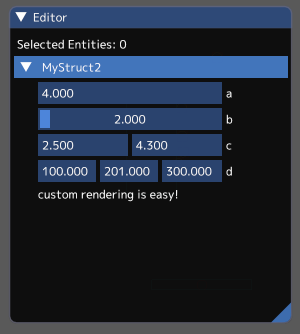Oversimplified, this is an implementation of a property editor using ImGui and Rust.
More specifically, this crate aims to be a serde for inspecting with imgui. It defines a common interface for getting values into imgui and back out. While there are some default implementations for certain types to be drawn as certain widgets, the primary goal is to make it easy to implement your own preferred way of rendering values.
- There is a trait for each widget type (i.e.
InspectRenderSlider) - There is an impl for each value type (i.e.
f32)
The overall design of this crate is unlikely to change, but very few imgui widget types and value types are implemented.
Most of the future work will be:
- Add traits for each imgui widget type
- Define structs to represent valid options for that imgui widget
- Implement sensible defaults for std types
It's a fairly straightforward process and basic examples exist, but it does take time to add them.
I'll be extending this as I need support for more types, but if you need something that's missing, PR it! There are detailed instructions below.
The intent is that you can get an imgui property editor with minimal code changes
#[derive(Inspect)]
pub struct MyStruct {
pub first_value: f32,
pub second_value: f32,
}You can get slightly different behavior by marking up the struct members
#[derive(Inspect)]
pub struct MyStruct {
// Use a slider widget with the given min/max values
#[inspect_slider(min_value = 5.0, max_value = 53.0)]
pub sliding_value: f32,
}Internally, this is implementing InspectRenderDefault for MyStruct. But you can implement it manually if you need to do something custom.
impl InspectRenderDefault<MyStruct> for MyStruct {
fn render(data: &[&MyStruct], label: &'static str, ui: &imgui::Ui, args: &InspectArgsDefault) {
ui.text("custom rendering is easy!");
}
fn render_mut(data: &mut [&mut MyStruct], label: &'static str, ui: &imgui::Ui, args: &InspectArgsDefault) {
ui.text("custom rendering is easy!");
}
}The API allows mixing and matching Render traits and types that are being rendered. A single type can be renderered multiple ways by overriding the render_trait
pub trait InspectRenderMyCustomWidgetType<T> {
fn render(data: &[&T], label: &'static str, ui: &imgui::Ui, args: &InspectArgsDefault);
fn render_mut(data: &mut [&mut T], label: &'static str, ui: &imgui::Ui, args: &InspectArgsDefault);
}
#[derive(Inspect)]
pub struct MyStruct {
#[inspect(render_trait = "InspectRenderMyCustomWidgetType")]
pub a_value: f32,
}This will call <f32 as InspectRenderMyCustomWidgetType>::render(...). This is useful for rendering the same type a few different ways.
Sometimes you want to implement your own rendering for a type in some other crate. But there's a problem.. traits can only be implemented in the same crate as the trait or the type itself.
You can either wrap the type yourself (i.e. struct MyVec2(glm::Vec2)) or you can use a dummy type and override the proxy_type.
struct ImGlmVec2;
impl InspectRenderDefault<glm::Vec2> for ImGlmVec2 {
fn render(data: &[&glm::Vec2], label: &'static str, ui: &imgui::Ui, args: &InspectArgsDefault) {
// ...
}
fn render_mut(data: &mut [&mut glm::Vec2], label: &'static str, ui: &imgui::Ui, args: &InspectArgsDefault) {
// ...
}
}
#[derive(Inspect, Clone)]
pub struct MyStruct {
#[inspect(proxy_type = "ImGlmVec2")]
pub position: glm::Vec2,
}This type is never instantiated. It's just used to resolve the function that should be called: <ImGlmVec2 as InspectRenderDefault>::render(...)
Remember you can always use a proxy type if you don't want to upstream changes, or if you dislike the default implementation!
This is easy to do and only requires changing imgui-inspect
- Many examples are located in imgui-inspect/src
- Add a new module
[WIDGET]/[WIDGET]_[TYPE]- EXAMPLE:
slider/slider_f32.rs
- EXAMPLE:
- Add an implementation:
impl InspectRender[WIDGET]<[TYPE]> for [TYPE]- EXAMPLE:
impl InspectRenderSlider<f32> for f32
- EXAMPLE:
In summary, we need to add a trait for the widget, implement the trait for some types, and add widget/config options to the proc macro
- Add the trait
- Add
InspectArgs[WIDGET]andInspectRender[WIDGET]toimgui-inspect/src/[WIDGET]/mod.rs - EXAMPLE:
InspectArgsSliderandInspectRenderSliderinimgui-inspect/src/slider - The values in
InspectArgs[WIDGET]are the options that can be fed into imgui - The implementations for
InspectArgs[WIDGET]should pipe these values into the imgui widget
- Add
- Implement the trait for types by following the above instructions "Adding a default widget implementation for a value type"
- Add the widget to the proc macro
- Add
InspectFieldArgs[WIDGET]andInspectArgs[WIDGET]toimgui-inspect-derive/src/inspect_macro/args/[WIDGET]_args.rs- EXAMPLE:
InspectFieldArgsSliderandInspectFieldArgsSliderinslider_args.rs InspectArgs[WIDGET]is a copy-paste of the same struct in inspect-imgui. (It's duplicated because a proc_macro crate cannot export a type)InspectArgs[WIDGET]are the values unique to the widget, andInspectFieldArgs[WIDGET]is every single property that can be changed via the macro
- EXAMPLE:
- This structs
InspectArgsDefaultandInspectFieldArgsDefaultshould be a superset of all args possible for any widget. Update:imgui-inspect-derive/src/inspect_macro/args/default_args.rsimgui-inspect/src/default/mod.rs
- Update
handle_inspect_types()inimgui-inspect-derive/src/inspect_macro/mod.rs - Add widget type to proc_macro_derive in
imgui-inspect-derive/src/lib.rs
- Add
Generally, you don't want to ship imgui in your end product. However, conditionally including the proc_macro is awkward. Rust will complain about any macros that it isn't told about, so removing the imgui-inspect-derive dependency from a project conditionally requires noisy markup.
To solve this, the imgui-inspect-derive macro uses a feature "generate_code." Disabling default features will prevent code from being generated.
Steps:
- make imgui-inspect optional
- Example:
imgui-inspect = { version = "...", optional = true }
- Example:
- Turn off imgui-inspect-derive default features
- Example:
imgui-inspect-derive = { version = "...", default-features = false }
- Example:
imgui-inspect-derive generates boilerplate code but doesn't actually depend on imgui. Disabling default features means the generate_code feature will be disabled, causing the macros to be parsed, but no code to be emitted.
All contributions are assumed to be dual-licensed under MIT/Apache-2.
Distributed under the terms of both the MIT license and the Apache License (Version 2.0).
See LICENSE-APACHE and LICENSE-MIT.

